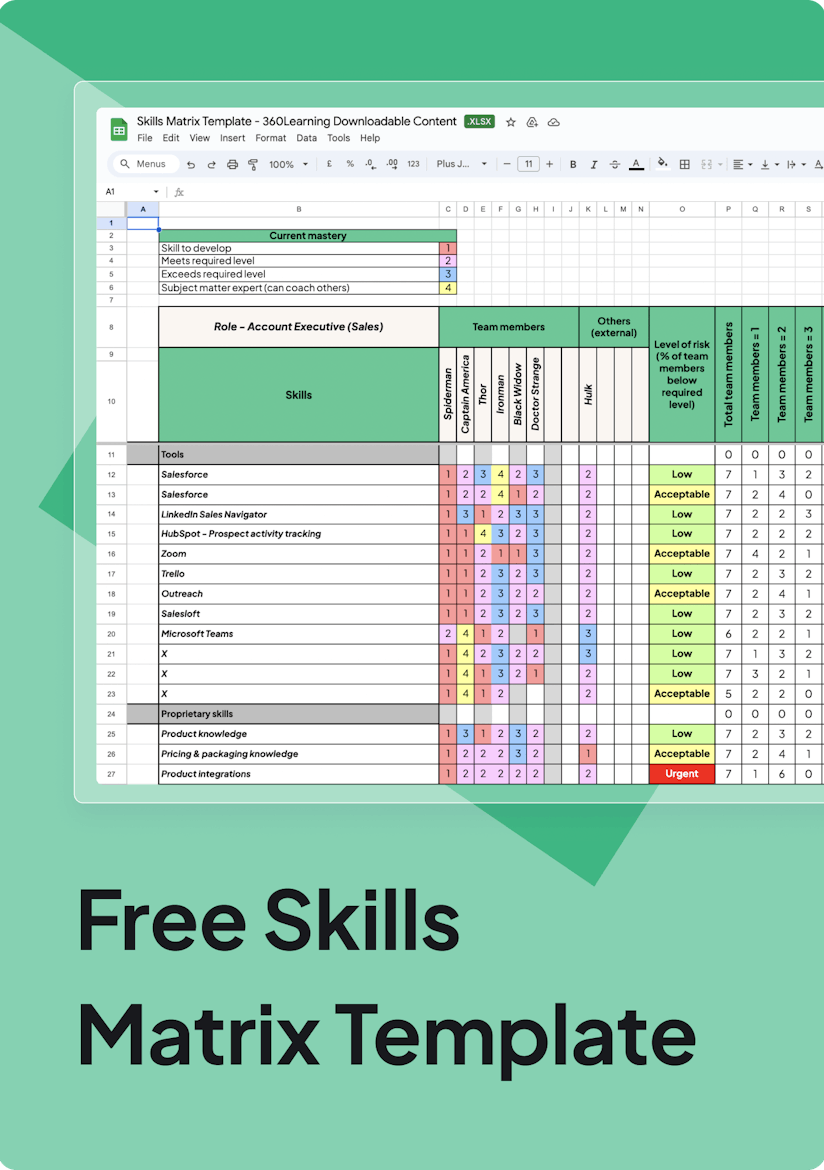
Discover the learning platform powered by collaborative learning.
A 15-minute discussion with an expert
100% tailored to your needs - with ❤️
No commitment. Free as can be.
Skills-based learning is the focus of the L&D community right now — and rightly so. But it isn’t a new concept. Skills mapping has been around for a while, and has long been considered a notoriously time-consuming and arduous task.
But the times are a-changing, and fast-moving technologies have become both an obstacle and a solution. Skills gaps are widening faster than ever, thanks in large part to the new technologies disrupting and pushing industries forward. Essential employee skills are evolving, as is employee development.
But we can also thank new technology for making skills management easier and more effective. And that includes the way L&D teams use tools like skills matrices. AI-powered solutions are making it not only possible, but simple for L&D professionals to map skills and create excellent upskilling and reskilling programs.
This article shows you how to create a great skills matrix. We then explore the exciting new possibilities to do this faster and more effectively than any Excel template.

By providing your contact info, you agree to receive communications from 360Learning. You can opt-out at any time. For details, refer to our Privacy Policy.
A “skills matrix” — sometimes known as a “capability matrix” — is a table, chart, or other graphical representation of the skills your team has.
By identifying skill gaps, L&D teams can assess what types of employee training programs need to be created, and subsequently build training programs that provide team members with the missing skill sets.
L&D teams have traditionally used methods like these to create an overview of their workforce’s skills (skills mapping) and measure individual or group proficiency in specific areas.
Used well, the matrix also helps you break down silos as an organization. By clearly showing the shared capabilities across teams, you open the possibility for better collaboration and mobility between roles.
A “competency matrix” is a related concept which measures the level of proficiency employees possess in specific skill areas. In theory, you would first identify the core skills required in a role, and then measure these on an individual basis using the competency matrix.
Skills matrices tend to be used more operationally by L&D teams, whereas a competency matrix can also be used as a reference for external hiring, managing performance, and developing internal mobility initiatives.
In reality, the two terms are largely used interchangeably. We prefer to focus on skills rather than competencies, as the term is better understood by leadership and the wider organization, and usually aligns easily with company goals.
As 360Learning Chief Learning Officer David James says, “Skills is a language many in the organization know and relate to. Leaders are aware of skills gaps in their industry as it's the language of the media, their peers in other orgs and senior HR. It's also the language of employees via recruitment firms and their peers. We don't need to change anybody's minds, we just need to show them how.”
Related: Listen to the latest episodes on David James' Learning & Development Podcast
The short answer is: yes. If you want a skills-based learning strategy (and to reap the benefits of skilling employees), you need a clear map of organizational needs versus your current status.
A good skills matrix lets you define:
As a learning and development professional, a solid skills matrix is often a prerequisite to designing a learning strategy, and getting buy-in from leadership, managers, and the wider workforce.
Which may not be what you wanted to hear. Skills mapping has a reputation for being time consuming and full of complexities. But this is no longer the case.
Whether in Excel, slides, or an LMS system, creating a skills matrix is relatively simple — in theory. The classic method involves just three key steps, but we’ve added a fourth which will take the process to a whole new level.
Before you can assess skills at the employee or team level, you need to define what you’re assessing. This feels like it should be an easy task, but rarely is. It usually involves meetings and discussions with stakeholders, which don’t always provide the clarity you’d like.
As L&D pro Brandon Caldwell explains, “I’ve been on calls with a team of L&D professionals, SMEs and executives for hours and days on end, trying to define what a person in a particular role needs to know and what skills they need. It’s an excruciatingly long exercise, even if you’re intimately familiar with the particular role you are talking about.”
AI technology can really speed this up, as we’ll see next.
Supposing you’ve reached some level of consensus, your naming structure matters, too. Every skill in the matrix should be:
L&D teams shouldn’t aim to create an all-encompassing skills-based learning strategy on day one. And your matrix doesn’t have to be comprehensive for the whole organization right away.
Instead, focus on business-critical skills and build confidence in your approach. Start small, be specific and make it work.
It can be a sensitive topic, but a logical grading system is essential to assess individuals and the organization overall. Your goal is to accurately, objectively, and compassionately determine individuals’ attainment of each particular skill.
Use a numbered or lettered system as a competency ladder. 1-5 makes sense, as does A-F. But be mindful that — just like in school — an “F” can really sting, and you may find managers avoiding the lower end even for new team members who rightly haven’t built up knowledge yet.
Your findings will only be helpful to you if they provide an evenly-weighted picture of your workforce's talent and abilities. And they'll only be helpful to your team members if your grading system is intuitive and easy to read.
Finally, set clear boundaries ahead of time. If possible, write out the criteria in an index first, so you're consistent about how you classify data. Ensure that every team member knows why they need the necessary skills, and how to read the results of an assessment.
There are numerous ways to conduct skills assessments, each with its own benefits and downsides:
Your best choice is really a mix of all three. You might start by asking senior leaders what they see as the biggest skills priorities and current gaps. Then, with a mix of self- and manager-evaluations, you’ll get a better sense of current aptitude levels.
A smart alternative to focus groups and regular stakeholder meetings is getting help from generative AI. New tools can create custom skills matrices in no time at all — built from a wealth of data you’d never dream of reading through yourself.
Tools like SkillsGPT (which we’ll see shortly) can quickly:
In one fell swoop, you essentially replace two of the three steps above. And you have a process to easily update your matrix whenever you like.
All of which sounds amazing in theory. But does it really work in practice?
The time and effort that goes into listing out skills and mapping them against job roles is daunting. LinkedIn’s own skills ontology has more than 30,000 possible options! But while having a skills matrix is essential for most L&D teams, building it adds little value. That’s why you’re looking for a template.
And because new skills are developed and prioritized each day, skills matrices go out of date quickly. Which means you can’t afford to take months to build a skills matrix.
Which is where new AI tools are particularly valuable.
SkillsGPT by 360Learning lets anyone with a ChatGPT Plus subscription build a skills ontology in record time. It uses those 30,000 LinkedIn skills, plus our proprietary data and experience as a leading LMS, to give you a skills matrix better than any template.
SkillsGPT by 360Learning will:
Of course, you can customize and refocus this along the way. Your ontology will be yours. But the amount of time and energy you save — and the reassurance that your skills matrix follows best practices — is enormous.
And the best part: it’s just as quick to update.
Good skills mapping should be accurate, efficient, and iterative. You can’t hope to build a matrix today that will still be relevant 12 months from now. So the faster and smoother the process, the more useful your matrix will be.
That’s exactly why we built SkillsGPT. Avoid taking weeks or months building matrices, and instead focus your efforts on training and smart resource allocation.
L&D and HR teams need to spend less time on documentation and project management, and more time helping employees develop their skills for this role and beyond.
We now have the tools to do this. Get started today.
A 15-minute discussion with an expert
100% tailored to your needs - with ❤️
No commitment. Free as can be.
By providing your contact info, you agree to receive communications from 360Learning. You can opt-out at any time. For details, refer to our Privacy Policy.
What is a skills matrix?
Why should L&D teams use a skill matrix?
What is SkillsGPT and how does it work?